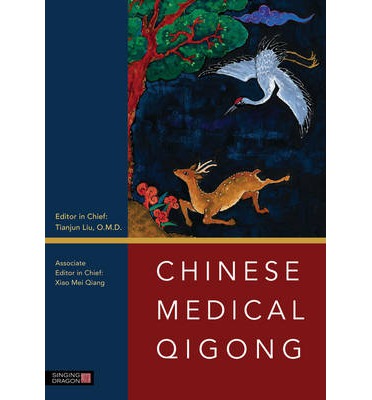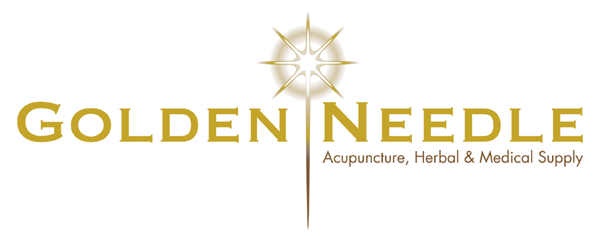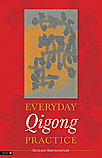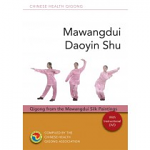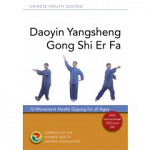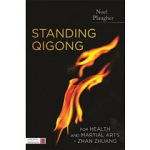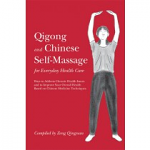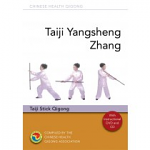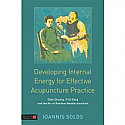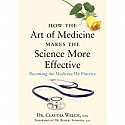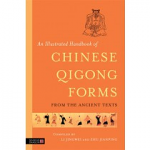Based on the latest edition of the approved textbook on Medical Qigong used in Chinese universities, this authoritative paperback edition has been completely revised and edited to meet the needs of western practitioners. The editors emphasize the practice of Qigong, and this section of the book has been revised and expanded; a wide range of Qigong forms are presented, taking full account of the history, correct practice, and development of Qigong. The section on the clinical applications of Qigong in the treatment of a wide range of conditions, with the recommended Qigong forms for treatment, and relevant references to the ancient texts has been substantially revised, and focuses on conditions more common in the West. The book also presents the newest research on Medical Qigong, including groundbreaking new discoveries about the physiological and psychological mechanisms. Omitted from this paperback edition are the extensive excerpts from the ancient texts, and the detailed history, more appropriate for academic study.
This is an unparalleled resource for practitioners of Qigong and Chinese medicine, as well as medical students and other healthcare professionals seeking a better understanding of the theory, practice and beneficial health applications of Medical Qigong.
Foreword. General Introduction. I. Essential Concepts of CMQ. II. The Academic System of CMQ. III. Subjects Related to CMQ. IV. The Study of CMQ. Part I: Fundamental Theories. 1. The Origins of Qigong and the Major Schools. Section 1: The Origin of Qigong. I. Historical Texts. II. Medical Texts. III. Archaeological Discoveries. Section 2: Traditional Major Qigong Schools. I. Medical Qigong. II. Daoist Qigong. III. Buddhist Qigong. IV. Confucian Qigong. V. Martial Arts Qigong. 2. Classical Theories. Section 1: Theories of Medical Qigong. I. Theory of Yin-Yang and the Five Elements. II. Zang-Fu (Visceral Manifestation) and Meridian Theory. III. The Theory of Essence-Qi-Spirit. Section 2: Theories of Other Qigong Schools. I. Daoist Qigong Theory. II. Buddhist Qigong Theory. III. Confucian Qigong Theory. IV. Martial Arts Qigong. 3. Modern Scientific Research on Qigong. Section 1: Summary of Modern Research on Qigong. I. Development of Modern Research on Qigong. II. Trends and Controversy in Qigong Research. Section 2: Physiological Effects of Qigong. I. Effects of Qigong on the Respiratory System. II. Effect of Qigong on the Cardiovascular System. III. Effects of Qigong on Neuroelectrophysiology. Section 3: Psychological Effects of Qigong. I. Operational Mechanism of Adjusting Mind in Qigong Practice. II. Psychological Elements of External Qi Therapy. Part II Practical Methods and Skills. 4. Basic Operations of Qigong. Practice. Section 1: Adjustment of Body. I. External Adjustments. II. Internal Adjustment. Section 2: Adjustment of Breath. I. Adjustment of Breathing Types. II. Adjustment of Breathing Air. Section 3: Adjustment of Mind. I. Operation of Mind Adjustment (Yi Nian Tiao Kong). II. Adjustment of the Mental Realm (Jing Jie Tiao Kong). Section 4: Integrating Three Adjustments into One. I. Consolidating Method. II. Extending Method. III. Characteristics of the State Integrating Three Adjustments into One. 5. General Introduction to Qigong Forms. Section 1: Classification of Qigong Forms. I. Classification of Qigong by Academic Schools or Traditions. II. Classification by Dynamic/Static Types. III. Classification by the Three Adjustments. IV. Classification by Practice Style or Characteristics. Section 2: Guidelines and Precautions for Practice. I. Guidelines. II. Precautions Before and After Practicing. Section 3: Possible Reactions to Qigong Practice. Normal Reactions. II. Adverse Reactions. Section 4: Qigong Deviations and Corrections. I. The Causes of Deviation. II. Symptoms of Deviation. III. Classifications. IV. Treatment Methods for Correction of Deviations. 6. Selected Qigong Forms. Section 1: Five-Animal Frolics. I. Practice Method. II. Application. Section 2: The Six Syllable Formula. I. Practice Method. II. Application. Section 3: Muscle/Tendon Changing Classic. I. Practice Method. II. Application. Section 4: Eight Pieces of Brocade. I. Practice Method. II. Application. Section 5: Five Elements Palm. I. Practice Method. II. Application. Section 6: Health Preserving Qigong. I. Practice Method. II. Application. Section 7: Post Standing Qigong. I. Practice Method. II. Application. Section 8: Relaxation Qigong. Practice Method. II. Application. Section 9: Internal Nourishing Qigong. I. Practice Method. II. Application. Section 10: Roborant Qigong. I. Practice Method. II. Application. Section 11: New Qigong Therapy. I. Practice Method. II. Application. Part III Clinical Applications. 7. General Introduction to Qigong Therapy. Section 1: Characteristics and Indications of Qigong Therapy. I. Characteristics of Qigong Therapy. II. Indications and Contraindications of Qigong Therapy. Section 2: Principles of Administering Treatment by Syndrome Differentiation in Qigong Therapy. I. Recognizing TCM Syndromes and Administering Qigong by Syndrome Differentiation. II. Administering Qigong Suitably to Individual, Time, and Location . Section 3: Standard Procedures and Clinical Routine of Qigong Therapy. I. Qigong Prescription. II. Qigong Treatment Methods. III. The Treatment Process of Qigong. IV. Writing Medical Records. Chapter 8. Examples of Clinical Application. Section 1: Hypertension. I. Main Qigong Forms. II. Administer Qigong Forms by Syndrome Differentiation. III. Cautions. Section 2: Coronary Artery Disease. I. Main Qigong Forms. II. Administer Qigong Forms by Syndrome Differentiation. III. Cautions. Section 3: Peptic Ulcers. I. Main Qigong Forms. II. Administer Qigong Forms by Syndrome Differentiation. III. Cautions. Section 4: Chronic Liver Diseases. I. Main Qigong Forms. II. Administer Qigong Forms by Syndrome Differentiation. III. Cautions. Section 5: Diabetes Mellitus. I. Main Qigong Forms. II. Administer Qigong Forms by Syndrome Differentiation. III. Cautions. Section 6: Obesity. I. Main Qigong Forms. II. Administer Qigong Forms by Syndrome Differentiation. III. Cautions. Section 7: Menopause Syndrome. I. Main Qigong Forms. II. Administer Qigong Forms by Syndrome Differentiation. III. Cautions. Section 8: Chronic Fatigue Syndrome. I. Main Qigong Forms. II. Administer Qigong Forms by Syndrome Differentiation. III. Cautions. Section 9: Insomnia. I. Main Qigong Forms. II. Administer Qigong Forms by Syndrome Differentiation. III. Cautions. Section 10: Tumor and Cancer. I. Main Qigong Forms. II. Administer Qigong Forms by Syndrome Differentiation. II. Cautions. Section 11: Lower Back Pain and Leg Pain. I. Main Qigong Forms. II. Administer Qigong Forms by Syndrome Differentiation. III. Cautions. Section 12: Cervical Spondylosis. I. Main Qigong Forms. II. Administer Qigong Forms by Syndrome Differentiation. III. Cautions. Section 13: Myopia. I. Main Qigong Forms. II. Administer Qigong Forms by Syndrome Differentiation. III. Cautions. Index.
Praise for the hardback edition:
'This is the first English translation of this ancient art of Chinese medicine. It is a must read for Traditional Chinese Medical Practitioners as it allows the traditional principles of qigong to be related to current scientific evidence. The book was generally an excellent read, being a great introduction to the practice of Qigong for both experienced and non-experienced TCM practitioners... as a sole English reference book in the practice of Qigong it makes an excellent reference text for any traditional Chinese medical practitioner... Personally, I found this book an excellent read as a practitioner of a more Western approach of acupuncture. It presented itself very well at demonstrating the approach of Qigong to many typically "Western" diagnoses, which I found useful as a mainly non-TCM practitioner. Overall, Chinese Medical Qigong is an excellent reference text in the TCM practice of Qigong a vital read for any practitioner.'
- JAACP (The Journal of the Acupuncture Association of Chartered Physiotherapists)
'This is a landmark work in the field of medical qigong... The book provides a great overview of qigong theory, research and practice for anyone who is interested in qigong therapy.'
- qigonghealing.co.uk
'Chinese Medical Qigong is the definitive work on this ancient medical system for the English-speaking world. It is an important addition to our understanding of the contribution of Chinese culture, tradition, and science to the art of healing.'
- Larry Dossey, M.D., author of Healing Words and The Power of Premonitions
'This is a long-needed and must-read book about the history, science, and practice of Chinese Medical Qigong. Clearly written, comprehensive, and visionary in scope.'
- Gary E. Schwartz, Ph.D., Professor of Psychology, Medicine, Neurology, Psychiatry, and Surgery, The University of Arizona, and author of The Energy Healing Experiments
'Chinese Medical Qigong is one of the most comprehensive English texts to be published on this subject to date. An important reference for anyone interested in medical Qigong.'
- Adam Perlman, M.D., M.P.H., F.A.C.P., Endowed Professor of Complementary and Alternative Medicine, University of Medicine and Dentistry of New Jersey
'This volume is an unparalleled presentation of current theory, research and practice in medical Qigong in China today. It will appeal to anyone interested in use of Qigong to promote health and wellness.'
- Donald D. Davis, Ph.D., Old Dominion University, VA, and Tidewater Tai Chi Center
'This is an important book, one that has the potential to bring Qigong into the clinical and research limelight in the U.S. so that this wonderful and ancient healing practice can be better understood scientifically. The history, concepts, and practical applications of Qigong are presented thoroughly and systematically. The book illuminates not only Qigong, but also sheds light on all of Traditional Chinese Medicine and deserves a wide readership among clinicians, researchers, acupuncturists, and all others working the field of integrative medicine.'
- Elizabeth R. Mackenzie, Ph.D., Lecturer, History and Sociology of Science, School of Arts and Sciences, University of Pennsylvania
'There are very few texts on the instruction of Qigong that address both the art and science of this form of movement meditation and therapy. Chinese Medical Qigong does both in a clearly documented and organized manner and does it well. The first English translation of the "only official textbook of medical Qigong utilized in TCM universities in China" does not suffer from translation but, rather, guides the reader through such diverse topics as Qigong history, theory, forms, research, and clinical application. Designed as a pedagogical tool, each section ends with a series of thought-provoking "Questions for Review," allowing the reader to reflect on and absorb the content... It is likely to become the "go-to" textbook in any medical program that includes Qi-based therapies or self-care.'
- Bonnie Povolny, LAc - The American Acupunterist
'The content of this book is extensive and all inclusive. It consists of fundamental theories, practical methods and skills, clinical applications of Chi Gong therapy, classical Chi Gong literature, and many other more. This textbook will be a useful tool for medical students and health care professionals who are interested in complementary and alternative therapies. It will also be an important resource book for anyone who practices mind-body exercise (i.e. Tai Chi and Chi Gong).'
- Violet Li - St. Louis Examiner
'This is a monumental work, put together by a host of editors from many Chinese medicine colleges in China as well as some prominent qigong teachers from the U.S. such as Kenneth Cohen and Roger Jahnke... Medical qigong is just becoming more well-known in the West and this book is a welcome and valuable addition to this exciting field.'
- The Empty Vessel
'What the wealth of material in this book should do is destroy a common idea that a weekend course in qigong is enough to qualify someone in its mastery... A worthwhile addition to any practitioner's collection.'
- Ejom.
